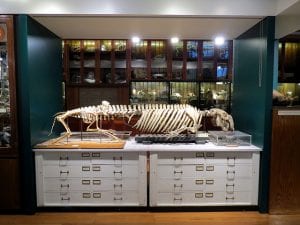As any lover of Attenborough will, I’m sure, understand, the idea that someone is not naturally interested in nature and zoology is something that I, as a researcher of primates (specifically, their gut bacteria), had never really considered before. Aware as I am that the fascinating but visually underwhelming (I’m sorry!) sea squirt might take a bit of effort to enthuse people I sort of assumed a general underlying love of at least all the four-legged, big-eyed, furry, woolly things of the world.
This wholly unreasonable assumption of mine was proven wrong during last week’s shift at the Grant Museum by one simple question from a very enthusiastic and lovely retired physicist:
“What would a group of physicists find interesting in a Zoology museum?”
What follow here are just two examples of nature seen through a different lens, which I hope go some way towards enthusing those not naturally curious about zoology.
All that glitters isn’t gold, all that shimmers isn’t green
Most of the green birds you see are pretenders. Rather than truly being green, they’re a beautiful example of something called structural colouring.
When you use paint to colour a surface, what you are applying are coloured molecules, called pigments. These produce colour through absorption of different wavelengths of light; to produce green, for example, red and blue light are absorbed whilst green light is reflected into your eyes.

The Green Honeycreeper, not a green bird. Photo credit: CC Image courtesy of Lip Kee on Flickr
First observed by Robert Hooke and Sir Isaac Newton and explained by Thomas Young a century later, structural colouring, however, is the production of colour through the interference of white light by microscopic surfaces, rather than absorption of certain wavelengths. This can work in conjunction with pigments — for example, a peacock feather is pigmented brown, but microscopically structured so that they reflect blue and green light, and also making them iridescent, showing different colours depending on the angle from which you view them.
Structural colouring in animals, particularly birds, can be a big evolutionary advantage. Creating pigments can be very energy-costly, and often requires rare elements that are difficult to extract from food during digestion, such as metals like cadmium, cobalt or chromium for green pigments. Structural colouring is an ingenious way to create these brilliant colours through feather shape alone, hugely useful when trying to attract a mate or hide from predators in the trees.
Turacos are the interesting exception to these structural colourists. Found in forests and woodlands in sub-Saharan Africa, these birds actually produce their own unique red and green pigments, called turacin and turacoverdin respectively, using an unusually high amount of copper. Just why they make this pigment is still a mystery. Their habitat coincides with the world’s richest copperbelt, leading some to speculate that this pigment production might’ve evolved to detoxify the large amount of copper these birds ingest through their food. Whatever the reason, this unique ability to use copper in this way makes turacos some of the only truly green birds.

A truly green Angolan Turaco. Photo credit: CC Image courtesy of C. P. Ewing on Flickr
There are many examples of structural colouring in the Grant Museum, from the peacock’s feather to the wings of iridescent butterflies and the gold sheen of some beetles. I highly recommend seeing how many you can spot next time you’re there.
A (constructal) theory of everything
It might not be the unified theory that Stephen Hawking is searching for, but the Constructal Law is a physics theory that can be used to explain the shapes of all the bones, limbs and preserved animal specimens that you see around you in the Grant Museum.
In its simplest form, Constructal Law states that systems naturally evolve over time to minimise energy waste. Substitute the word “animals” for “systems”, and you have its application to zoology. This seems like an obvious benefit; wasting less energy allows animals to get the most out of the food they eat, allowing them to flee from predators faster, spend less time gathering food and more time chatting each other up, and produce better-fed offspring. Where this rule becomes most interesting though is when you consider animal locomotion.
Even though running, flying and swimming have all evolved as separate methods of locomotion, they’re all linked by this simple physics principle. Despite involving very different body mechanics, it turns out that there is a universal relationship between animals’ mass and speed, as well as the frequency and force of limb or tail movement, whether those are legs, wings or fins. The relationship between a winged animal’s mass and the frequency of their wing beats shows the same relationship as between mass and rate of swimming in fish, as well as mass and stride frequency in running animals, and has all evolved to move the animal at optimal speed, reducing energy wastage whilst maintaining quick movement. No other factors, such as type of creature, limb length, wingspan or otherwise, seem to factor in to this, only body mass and limb or tail movement.

Paddling and running on display at the Grant Museum. Photo credit: CC Image courtesy of Justin Pickard on Flickr
This principle helps determine how animals move around and is a brilliant example of how the great diversity of life still converges to fit fundamental physics principles. Next time you’re in the Grant Museum, have a think about how all the animals around you have been shaped in part by this universal law.
The physicist I met got me to consider the animal specimens in the museum from a whole new angle, making me think about what different people would find interesting about zoology and, importantly, why, rather than just assuming everyone has an inbuilt love. Just like the iridescent wings of certain animals, looking at a familiar collection from a different angle can offer a whole new view on zoology. And seriously, give the sea squirt a chance.


 Close
Close









